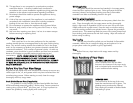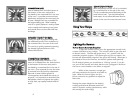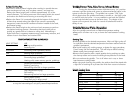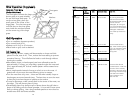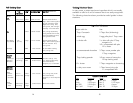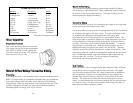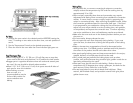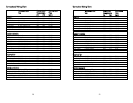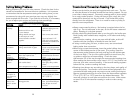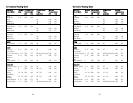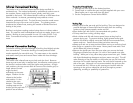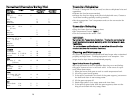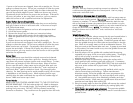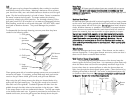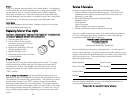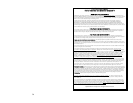
23
CCoonnvveennttiioonnaall//CCoonnvveeccttiioonn RRooaassttiinngg TTiippss
Always use the broiler pan and grid supplied with each oven. The hot
air must be allowed to circulate around the item being roasted. Do not
cover what is being roasted. Convection roasting seals in juices quickly
for a moist, tender product. Poultry will have a light, crispy skin, and
meats will be browned, not dry or burned. Cook meats and poultry
directly from the refrigerator. There is no need for meat or poultry to
stand at room temperature.
•Always roast meats fat side up. No basting is required when the fat
side is up. Do not add water to the pan, as this will cause a steamed
effect. Roasting is a dry-heat process.
•Poultry should be placed breast side up on the grid in the broiler pan.
Brush poultry with melted butter, margarine, or oil before and during
roasting.
•For convection roasting, do not use pans with tall sides, as this will
interfere with the circulation of heated air over the food.
•If using a cooking bag, foil tent, or other cover, use conventional
baking rather than convection.
•When using a meat thermometer, insert the probe halfway into the
center of the thickest portion of the meat. (For poultry, insert the
thermometer probe between the body and leg into the thickest part
of the inner thigh.) The tip of the probe should not touch bone, fat,
or gristle to ensure an accurate reading. Check the meat
thermometer 2/3 of the way through the recommended roasting time.
After reading the thermometer once, insert it 1/2” (1.3 cm) further into
the meat, then take a second reading. If the second reading registers
below the first, continue cooking the meat.
•Roasting times always vary according to the size, shape, and quality of
meats and poultry. Less tender cuts of meat are best prepared in the
conventional bake setting and may require moist cooking techniques.
Remove roasted meats from the oven when the thermometer registers
5
O
F to 10
o
F (-15
o
C to -12
o
C) lower than the desired doneness. The
meat will continue to cook after removal from the oven. Allow roasts
to stand 15 to 20 minutes after roasting in order to make carving
easier.
22
SSoollvviinngg BBaakkiinngg PPrroobblleemmss
Baking problems can occur for many reasons. Check the chart for the
causes and remedies for the most common problems. It is important
to remember that the temperature setting and cooking times you are
accustomed to using with your previous oven may vary slightly from
those required with this oven. If you find this to be true, it is necessary
for you to adjust your recipes and cooking times accordingly.
BBAAKKIINNGG PPRROOBBLLEEMM RREEMMEEDDIIEESS
PPRROOBBLLEEMM CCAAUUSSEE RREEMMEEDDYY
Food browns Improper heating Preheat until oven
unevenly indicator light goes out.
Aluminum foil on rack Remove foil.
or oven bottom
Baking utensils too large Use correct size utensil.
for the recipe or oven.
Several utensils crowded Leave at least 1 1/2”
together (3.8 cm) or more space
between all utensils and
oven walls.
Food too brown Baking utensil too large Use correct utensil
on bottom Baking utensil dark or glass Lower oven temperature
25
o
F (-3.8
o
C) for this type
of utensil.
Food dries Oven temperature too high Lower oven temperature
before Oven door opened too Check food at minimum
browning frequently time.
Cookies too Pans too deep Use a cookie sheet (not a
brown on baking pan).
bottom Dark cookie sheet Use light, shiny cookie
sheet.
Oven temperature too high Lower oven temperature
Cookies too Hot cookie sheet Allow cookie sheet to
flat cool between batches.
Cake too brown Oven temperature too high Lower temperature;
on bottom or if using glass pan, lower
crust forms on 25
o
F (-3.8
o
C)
bottom
Cakes burns on Oven too hot Reduce temperature.
sides or not Wrong pan size Use recommended pan
done in center size; fill pan no more
than 2/3 full.



